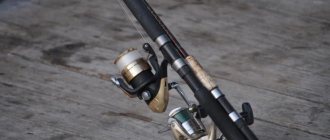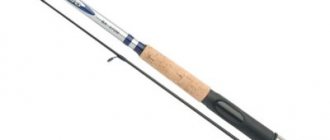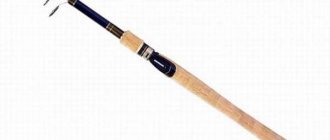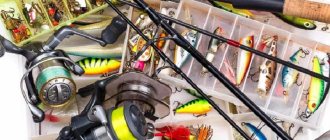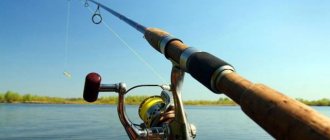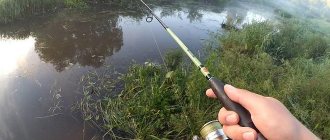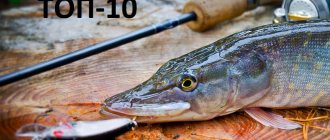The choice of spinning rod must be approached with all responsibility and seriousness. Because high-quality gear will not only last longer, but will also bring much more trophies and joy to the owner.
Spinning is a fishing tackle designed for use on a variety of bodies of water, various types of fish, and artificial and natural bait.
A fisherman, throwing a bait into a pond and reeling in a fishing line, involuntarily imitates a swimming fish. The predator, reacting to this, grabs the bait and gets hooked. The components of a spinning rod are a rod with guides, reels, and fishing lines. The shape of the blank is a long, thin cone. It is held by the thicker part, called the butt. And the uppermost, thinnest part is called the tip.
All spinning rods are divided according to their design:
- telescopic (retractable) - 4-6 docking units, but they make the form heavier and reduce its strength. The advantage is that it is small in size and can be easily folded;
- composite (plug-in) - have become more widespread, they usually have 2 elbows, and their weight is light.
Plug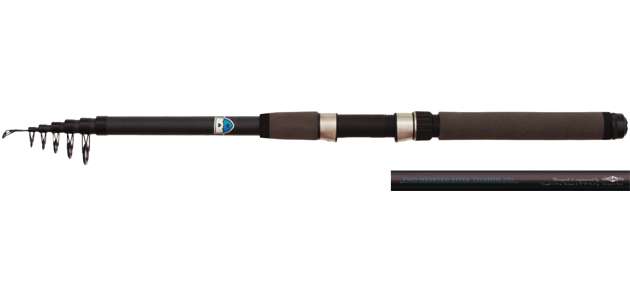
Telescopic
Key spinning parameters
Length
A long spinning rod is convenient for long-distance casting, but in cramped circumstances it will be very inconvenient to hunt with.
The most common 2 to 3 m can be successfully used:
- on small rivers;
- on banks overgrown with various vegetation and water covered with duckweed;
- from the boat.
For distant casting and sea fishing, use 3-4 m or more. When you have to hunt in various bodies of water, the most universal length is 2-2.7 m. This length is good for practicing the technique of casting bait.
Test
The word test translated from English means “sample, test”, and means the optimal weight range of the bait used. Shows the minimum and maximum sensitivity of the rod.
Example: a test from 8-40 g will indicate that the optimal weight of the bait can only be from 8-40 g. If it is less than 8 gr. and more than 40 gr. - this will lead to loss of control over the bait and even damage to the rod.
That is why it is necessary to strictly adhere to the weight of the baits used; they are indicated in the spinning test. This is not difficult to do, all baits have their own weight parameters, if they are not suitable, use another form with a suitable test.
This means that you need to choose a spinning rod based on the characteristics of the bait you are going to hunt.
Classification:
- Ultralight (UL - UltraLight) - up to 6 g.
- Light (L – Light) – from 6-11 g.
- Medium (M - Moderate) - from 19-23 gr.
- Medium-light (ML - Moderate Light) - up to 11-19 g.
- Moderate Heavy (MH – Moderate Heavy) – from 22-37 g.
- Heavy (H – Hard) – up to 35-45 gr.
- Super heavy (XH – Extra Heavy) – more than 45 g.
Build
The formation is a certain form of bending of the spinning rod, which occurs under static load - when fishing, casting fish, and the sensitivity of the blank. Much depends on the material, shape, number of links.
Divided into 4 classes:
- Very fast (Extra Fast) - under the influence of static, 1/5 of the form will bend from the tip;
- Fast - only the tip will bend, ideal for precise casting;
- Medium (Moderate) - bends by 1/3;
- Slow – will bend 1/2.
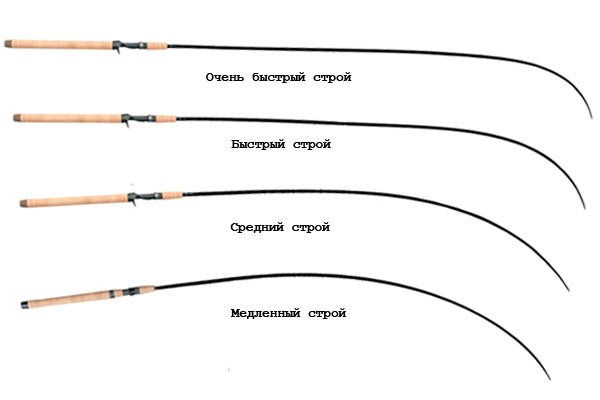
“ Fast ” - acts instantly when casting, the time interval between flight and swing is lightning fast. It is good at making accurate casts, makes reliable hooks and power landings.
“ Slow ” - at first it arches strongly, then, as it were, “shoots” the bait. It has a longer range, works better over a wide range, and has a “soft” fighting action.
Form material
Modern forms are made from: fiberglass, carbon fiber, composites.
- Fiberglass , especially heavy, is very strong, but has a small modulus of elasticity.
- Carbon fiber (carbon) - light, flexible, but very rigid, have a high elasticity modulus. They need to be handled more carefully because they are more fragile.
- Composite - the most common, made of composite material (glass fibers are added to carbon fiber). They have medium hardness.
- You can find fishing rods on sale with an admixture of Kevlar , this is a super durable material, body armor is made from it.
Features of fishing from a boat
Fishing from a boat has its own characteristics:
- When the fisherman is not in the central part of the vessel, but at the stern or bow, it will be convenient to cast a spinning rod directly from behind the back.
- If fishing takes place at great depths, the fisherman should not reel in the reel immediately, but in several steps, pausing between them.
- When casting in shallow places, the bait should be cast without waiting until it reaches the bottom, but immediately when immersed in the water.
- If you use vertical fishing while the vessel is drifting, then the most promising fishing rod is short and powerful.
- It makes sense to fish where there are dense thickets of algae, snags, boulders or various massive objects lying on the bottom.
- If it happens in late autumn, then the place where you can catch a large fish may be a distant dump of an underwater hole.
Which spinning rod is better to choose?
First, decide how and where you plan to hunt and what kind of fish. For the first time, a spinning rod with average values is suitable.
Fishing conditions
Before purchasing a fishing rod, first decide on the fishing conditions. How are you going to hunt: from a boat, shore, cliff or mountain river, etc.
To make the explanations more clear, I will give an example: we found a promising place, but it is located in a thicket of trees. There is only one way out - to make short but sharp wrist casts with a non-flexible blank, fast action. In open areas it can be easily swung. Therefore, it is more advisable to use a slow or medium tuning here.
Loot Selection
Also be sure to decide on your choice of prey in advance. What fish are you going to hunt and what bait to use.
Selection of test, scale, length
Test - should show the weight of the bait. The upper limit is the maximum permissible weight, the lower limit is the minimum weight. Example: test 2-7 g. will mean one thing, the form can only work with light baits.
But it is also possible to catch large prey, but you will have to fish it out longer. And to avoid breakdowns, you just need to adjust the friction brake. Build is the ability to bend under load. With a slow action, when fishing and casting, the rod will bend almost from the butt.
This is unacceptable for jigs, wobblers, jerkbaits. But for “turntables” and “oscillators”, this is a normal option. With a fast blank, only the upper third will bend under load. Medium action - has versatility, length - 1.9 to 3.2 m.
No defects on the rod
When purchasing, make sure there are no defects. Inspect everything carefully: is it well finished, what kind of assembly is it, the quality of the rings, how the varnish is applied. Are there any scratches, chips, or any defects? If necessary, ask the seller questions without hesitation.
Checking the reel seat and handle
The handle is now often made of cork and neoprene.
There are more expensive options, but this is irrelevant. A warmer handle is made from cork and has a different shape. You need to take the rod in your hand and hold it, you should feel whether it is comfortable for you or not. Inspect the tight fit of the handle to the form. There may be defects during production: the material may not be glued well, there may be visible damage. These defects will lead to rapid breakage of the handle.
Reel seat - there are different designs, so not every reel can be attached to it. It’s worth going to the store to grab it and try it on.
Manufacturer and cost
More than 50 manufacturers are known in Russia, here are some of them:
- Aiko Diestro-II
Aiko - price up to 400 USD - Maver Canna Eroica MX - about 300 USD
- BlackHole - the average price is no more than 100 USD, but the price of some models reaches 300 USD.
- Daiwa - the cost reaches 200 USD.
- G.Loomis - some copies cost 400 USD.
- Graphiteleader - the upper price limit reaches 350 USD.
- Mikado - the ceiling reaches 450 USD.
- Shimano - average cost, up to 80 USD
Rating of popular manufacturers
In the following rating we will try to describe the best spinning rods of various designs. This will help everyone quickly decide on their choice, taking into account their habits and preferences.
- Black Hole. This is the most universal form. Test bait range: 0.7-8.0 g. Suitable for everything: standing reservoirs, mountain rivers, but its “strong point”: twitching with various fishing techniques with minnows;
- irreplaceable: shads and fats;
- for microoscillators, oscillating spinners.
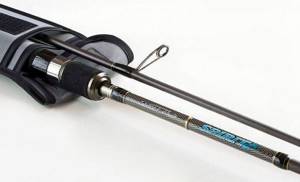
Black Hole
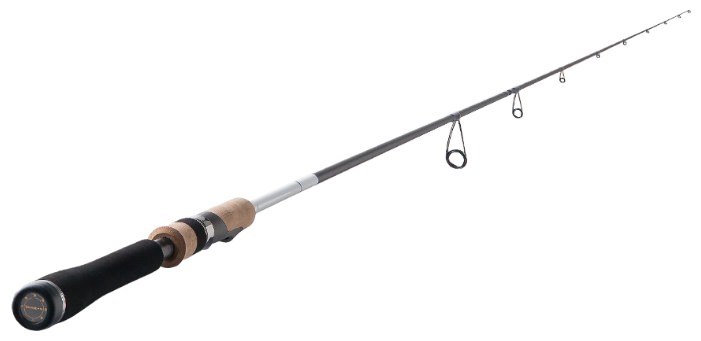
Tenryu Lunakia Magnam
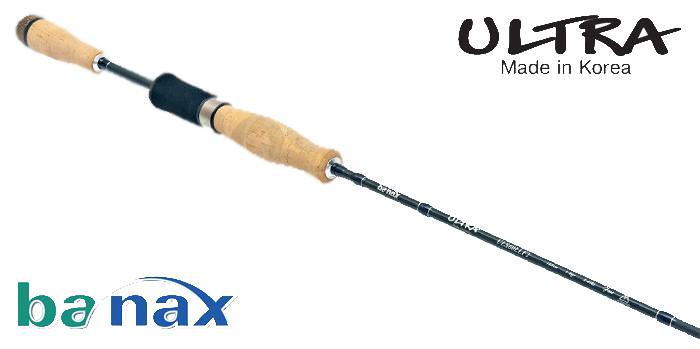
Banax Ultra

Norstream Areal Ar-60L
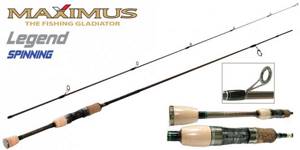
Maximus
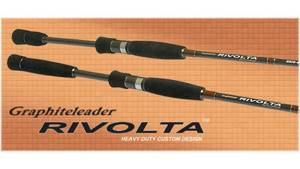
Graphitereader

Pontoon 21 Seven&Half
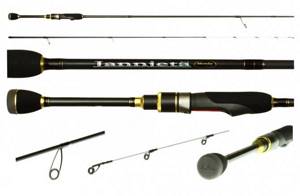
AIKO JANNJETA JNT732ULS
Shimano . This series has 9 models from:
- S707SULS (2.30 m; 0.5–3.8 g);
up to S803LT (2.53 m; 1.3–10 g). S706ULT - has a tubular tip. But there are also more modern ones - S709ULT, fast, tough, ultra-light class. Indispensable for wobblers and jigs.
Rod material
— The plug-in spinning rod has only 2 “elbows”. If you take it apart, you can get two independent parts that are not hollow.
Thanks to the design and use of new composite materials, the tackle can withstand significant loads, allowing you to successfully retrieve large fish from the water. The reduced weight was achieved without loss of strength, and in some cases with an increase in strength characteristics.
— Telescopic spinning rod is more convenient for transportation. When folded, the tackle has compact dimensions; when unfolded, it can reach a length of up to 3 meters. The telescope will come in handy if it is not possible to transport it on
- Fiberglass. The advantages of spinning rods made from this material are their inexpensive price and ease of maintenance. Their disadvantage is their large mass. Fiberglass rods are used when trolling, in which case frequent casting of bait is not required.
— Composite. Spinning rods made from this material have average rigidity. The composite is obtained by combining carbon fiber and fiberglass. Such rods are usually purchased if it is not possible to buy a carbon fiber rod.
— Carbon fiber or carbon fiber. Spinning rods made of carbon fiber have the lightest weight. Carbon fiber rods are classified according to their graphite content. The smaller the tackle module, the greater its flexibility.
- ultra-light UL - 1-7 g; - light L - 3-15 g; - medium M - 7-30 g; - medium-heavy MH - 15-40 g; - heavy H - 15-60 g and more.
— Ultra-fast tuning Extra-Fast (EF), in which 1/4 of the part is bent.- Fast tuning (F), 1/3 of the part is bent.- Medium tuning Moderate or Medium (M), half is bent.- Slow tuning Slow ( S) characterizes the bend of the 3/4 part.
In order to evaluate the structure of the spinning rod in the absence of markings, you need to rest its tip against any medium-hard object, determining the shape of the bend under load. The editors of Uznayvse.ru wish you good fishing and recommend that you read articles about Russia.
A fast (hard) action rod bends starting from 23 or 34 of its length, medium - from half, slow - from 1 quarter. The choice of rod structure depends on the type of fishing:
- For jig fishing, special sensitivity of the spinning rod is required. In this case, fast construction is the ideal option. It allows you to feel not only bites, but also the bottom.
- For jerking you need powerful tackle: a rod with a slow action is not suitable for heavy baits, and jerks weigh 40 - 200 g.
- For pike fishing with a spinner, the rod structure is not important. It can be fast, medium or slow. A rod of any stiffness will let you feel the bite of a large pike on a spinner.
Many anglers consider a medium-action spinning rod to be the best option for pike hunting (such rods are strong, elastic, and allow for precise casting and hard hooking). Others more often use a slow-action spinning rod: it is convenient to fish for pike. It also provides long, accurate bait casts.
The structure of a spinning rod can be determined by carrying out the following test: ask the seller or your friend to hold the rod by the tip, and slowly lift the spinning rod yourself and observe which part of the “stick” bends.
The material for making spinning rods is either carbon fiber (coal, graphite, carbon - the same thing), or fiberglass, or a mixture of both (composition). The latter are called “composite”.
Often, various fibers (for example, Kevlar fibers) are added to expensive models of spinning rods to give it additional rigidity, strength or other properties. Fiberglass spinning rods are the most flexible and heaviest with a low elastic modulus.
Coal “sticks” are relatively hard and light. Composite spinning rods are something in between.
Now on the market there are mainly graphite or composite spinning rods, and pure fiberglass is quite rare - only in cheap models.
Graphite materials can also be different. Two graphite spinning rods of the same length can differ in structure, weight and power. There are many grades of graphite and there is no single classification of them. I will give just a few examples of the best brands of carbon fiber: IM 700, hipron, XT30, XT60, XT100, SC 42, SC 33.
Fiberglass spinning rods are usually too soft and heavy, but their price is usually an order of magnitude lower. On the shortest spinning rods (1.
5-1. 6 m) their weight is almost imperceptible, and the difference in price is decent.
Another thing is the rings. The fact is that cheap spinning rods have cheap (bad) rings, but we will talk about rings below.
But, if you are a beginner spinning angler and you have to fish on small rivers, then you can easily start with a “glass”.
Composite spinning rods are very popular and there are the largest number of them on the fishing market. If the spinning rod says “carbon” and the price is low enough, then most likely it is “composite”.
More honest manufacturers indicate the material on their products: any phrases with the word “composite”. The prices for such spinning rods are quite reasonable, and their quality is quite high.
Such spinning rods can be called universal, and it is recommended to purchase a composite spinning rod for the first time. While there is no experience in handling charcoal sticks, which are very delicate both to use and to store, you can use a composite.
You will get even more pleasure if you subsequently switch to high-quality coal.
Spinning rod coating
The highest quality spinning rods have a transparent varnish coating. The structure of the material is usually visible through the coating. The color of such spinning rods depends on the shade of the translucent varnish.
Cheaper models have an opaque coating. The same applies to fiberglass spinning rods.
Currently, there are a large number of manufacturers on the market whose spinning rods are considered the best. Among them there are several companies that are most popular among advanced spinners. It is their products that can be safely recommended for purchase by beginners.
These brands boast a wide variety of models, have excellent build quality and allow the fisherman to truly enjoy the fishing process. These brands include:
- Shimano
- Daiwa
- Stinger
- St.Croix
- G.Loomis
If we divide the best fishing rods from these brands by price groups, the picture will look like this.
The best budget spinning rods
- Shimano Alivio is the initial line of spinning rods, which is extremely popular;
- Shimano Catana – inexpensive “folk” spinning rods that have been on the market for more than 10 years;
- Stinger Viper is a high-quality and inexpensive model from a well-known domestic manufacturer;
The best spinning rods in the mid-price range
- Shimano Clarus is a time-tested spinning rod for the American market, which has also found popularity among domestic fishermen;
- Shimano Technium is an excellent long-range line of spinning rods that requires no introduction;
- Maximus Black Widow is a model with an excellent price-quality ratio.
The best spinning rods in the upper price range
- Shimano Antares is an excellent option for those anglers who prefer exclusively high-quality gear;
- G.Loomis IMX FORCELITE – in demand among jig fishing enthusiasts;
- G.Loomis STR1025S is an ideal option for twitching.
The main parameters of the rod are indicated both on the form itself and in the catalog - they reflect the spinning rod’s own technical capabilities. But each “stick” also has special properties that are more related to ease of handling and are assessed by us independently. We will talk about them further.
The declared parameters include the rod test, its length, action, weight and, of course, the material from which the spinning rod is made.
Choosing a spinning rod for a novice fisherman
If you are a beginner fisherman, then find an experienced fisherman and ask him to help you. Discuss any issues that interest you with him. Of course, you can, without worrying too much, settle on a “universal” spinning rod with a length of 2.7 m, test 10-25 g.
But the ideal arsenal of any fisherman should consist of several fishing rods, so that he can choose the most suitable one for each specific case.
First, decide where you will fish most often:
- In a deep-water river with an intense current, or in a small bay, lake, reservoir.
- From a boat or shore.
- Estimated sizes and types of aquatic inhabitants.
- Type of bait - you need to select a form for each type.
You need to decide which options are preferable for you. Optimal length: 1.6 -3 m.
- From the shore: on ponds, rivers, lakes, up to 100 m, length - 2.4 -2.9 m.
- For large areas, long casts, more than 100 m - from 2.8 and more.
Optimal material: carbon fiber content should be equal to 5 and 6 (M-5, M-6). Test:
- For small rivers. lakes, fishing for small fish and medium-sized specimens - from 5-20 gr.
- For long-distance casting - test from 20 g. and more.
- For trolling - from 60 gr.
The tuning should be slow; “turntable” and “oscillator” are suitable. Fast - for a jig, the wiring should be “stepped”. Medium tuning (“semi-parabolic”) - has versatility.
Tests to help you make the right choice
With a modern spinning rod you can cast even ultra-light baits over long distances. True, provided that the tackle is suitable for such baits. Test data helps determine the compatibility of a fishing rod with baits. They are applied on the spinning form.
For example, the numbers 5 - 20 on the form mean that the weight of the bait should be in the range from 5 to 20 grams. With an attachment of a different weight, the rod will be ineffective.
To catch pike with a spinning rod, both light and heavy artificial baits are used.
Trolling involves holding the bait along a certain horizontal line. For this type of wiring, a wobbler weighing 10 - 200 grams is suitable (10 - 60 grams - light trolling; 50 - 200 grams - heavy trolling).
Trophy pike can also be caught with very heavy sea wobblers for fresh water bodies with a weight of 150-600 grams.
Pike are caught with a jig at depth, often on large rivers where the current is very fast. The spinning rod for the light version of the jig is 14 - 56 grams, for the heavy one - 28 - 84 grams. The traditional unit of measurement for the jig is an ounce, which is equal to 28 grams. Jerk spinning rods are also divided into 2 types according to the weight of the bait:
- light - with dough 15 - 60 grams;
- heavy - with dough 50 - 150 grams.
Light spinners and spoons are designed for rods with a test weight of 15 - 60 grams, heavy spinners (60 grams) - for rods with a test weight of 50 - 150 grams.
As an example of choosing a spinning rod based on a test, let’s consider a specific situation. The intended prey is a large pike. There are wobblers 7 - 32 grams. We buy a rod with 10 - 30 grams of dough. The weight of the bait should not exceed the weight range specified in the test.
The power of a spinning rod (test) can be determined by the inscription on it. Power is indicated in grams - in the weight of the bait being thrown. For example “10-30 g”.
Rules of care and use
- All joints of the form must be kept clean . When transporting, be sure to use a fabric cover and purchase a tube. After fishing, you need to carefully wipe all the joints and put them in a case and tube.
- This will be relevant during transportation . The car drives, jumping on bumps, in the trunk lies next to a spinning rod, for example, a barbecue, with the next jump the form can easily break without a cover. The blank is made of high-modulus graphite and is especially fragile; if dropped even from a meter high, it can break or develop a crack.
- If, when connecting the knee, we hear the creak of sand . We take the knee back, with the same trajectory, and rinse it well with clean water and wipe it dry. For a better connection, the house should be periodically lubricated with a greasy lubricant, for example, stearin, candle wax, etc.
- In the summer, when it's very hot, the rod gets hot and the knees sometimes jam . Under no circumstances should you apply excessive force to disconnect or twist in different directions. You need to cool them: put them in the shade, or put them in water. Wipe dry and separate.
Passing rings
One of the most important parts of a spinning rod is the guide rings. The purpose of the guide rings is not just to hold the cord, but also to ensure minimal friction between the ring and the fishing line.
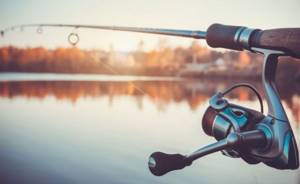
The material from which the rings are made plays an important role. The rings are of poor quality; from constant friction of the fishing line or cord against the ring, grooves form on the rings. Rings with such grooves literally wear out the fishing line in just a few casts and rewinds, which breaks during the next cast and the bait is shot. Bypass rings with defects cannot properly perform their intended functions and must be replaced.
You may be interested in: Fishing in Karelia: 30 best places
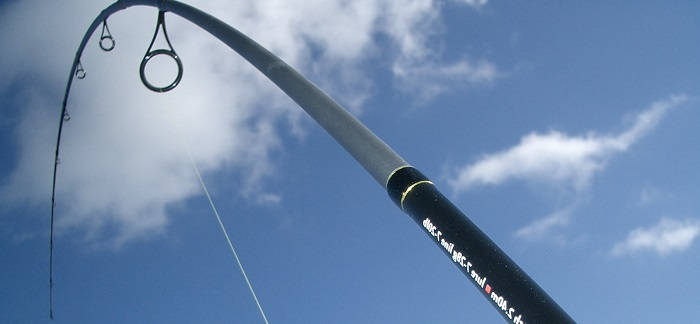
The number of throughput rings depends on the length of the spinning rod and the degree of its rigidity. The passage ring on the top of the spinning rod is called a “tulip”. Spinning rod guide rings can be made entirely of metal, or have a metal base with a ceramic, Teflon or fluoroplastic insert inside the ring. The best rings today are those with Alconite (black) and SIC (gray) inserts.
The inserts must be firmly held inside the passage rings without turning. The guide rings themselves must be firmly and tightly wound with thread to the rod blank.
The best places for spinning fishing
- All predators like to gather near small fish sites and set up ambushes nearby.
- There are good places on the river near the coastal cape, small fish usually accumulate there, which larger fish like to hunt for.
- Favorite places for many are near the dam, where pike have taken up residence at the bottom of the reservoir. In addition to pike, there is asp and perch.
- The best place on the river is a riffle, especially the initial section. Fishing here is universal, the combination of shallows and depth, calm and current, makes it possible to hunt for all available species: burbot, pike, pike perch.
- Every body of water has deeper places - holes; many types of predators prefer them.
- Underwater hills are the favorite place of all underwater inhabitants.
- Pike and perch like to hide in coastal thickets.
Tips and tricks
- for beginning spinning anglers to purchase a universal rod: test -3-14 g, 2.1-2.5 m in length. Hunting for serious fish: length - 2.5-2.8 m, test - 14-35 g.
- When mastering spinning fishing, it is better to start with a shore jig.
- When you plan to hunt large bodies of water from the shoreline, models with a fast action are optimal, test: 11-35; 7-29 g, length from 2.6 m.
- Fishing on a lake or pond - stick length 1.9-2.7 m, action will depend on the type of bait, test 2-13.5-17, 7-25 g.
Type of connection of spinning rod knees
Spinning rods can be either plug-in or telescopic, and plug-in rods come in two types: with an external and internal upper whip attachment.
Telescopic spinning rods are more convenient for transportation, but their quality leaves much to be desired. Due to the loss of length at the joints (10 cm x 5-6 joints = 50 cm), spinning rods become heavier for the same length.
The construction of such can only be quick, because... the lower knees practically do not work and the bending of such spinning rods is uneven. The rings on them are installed not where it is necessary, but where possible, i.e. at the ends of the knees.
Plug spinning rods are already professional equipment. Internal or external joint - this depends on the action and, as a rule, with fast action spinning rods, the upper whip is inserted into the lower one. Rings on plug whips are placed in specially designed places.
